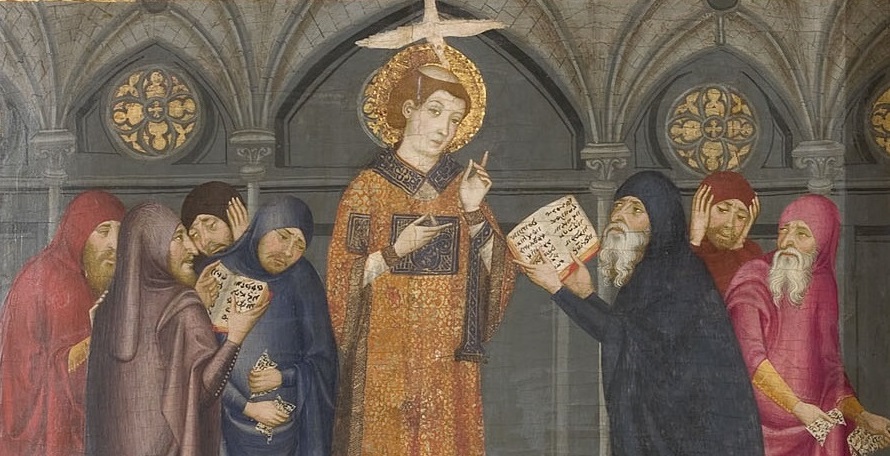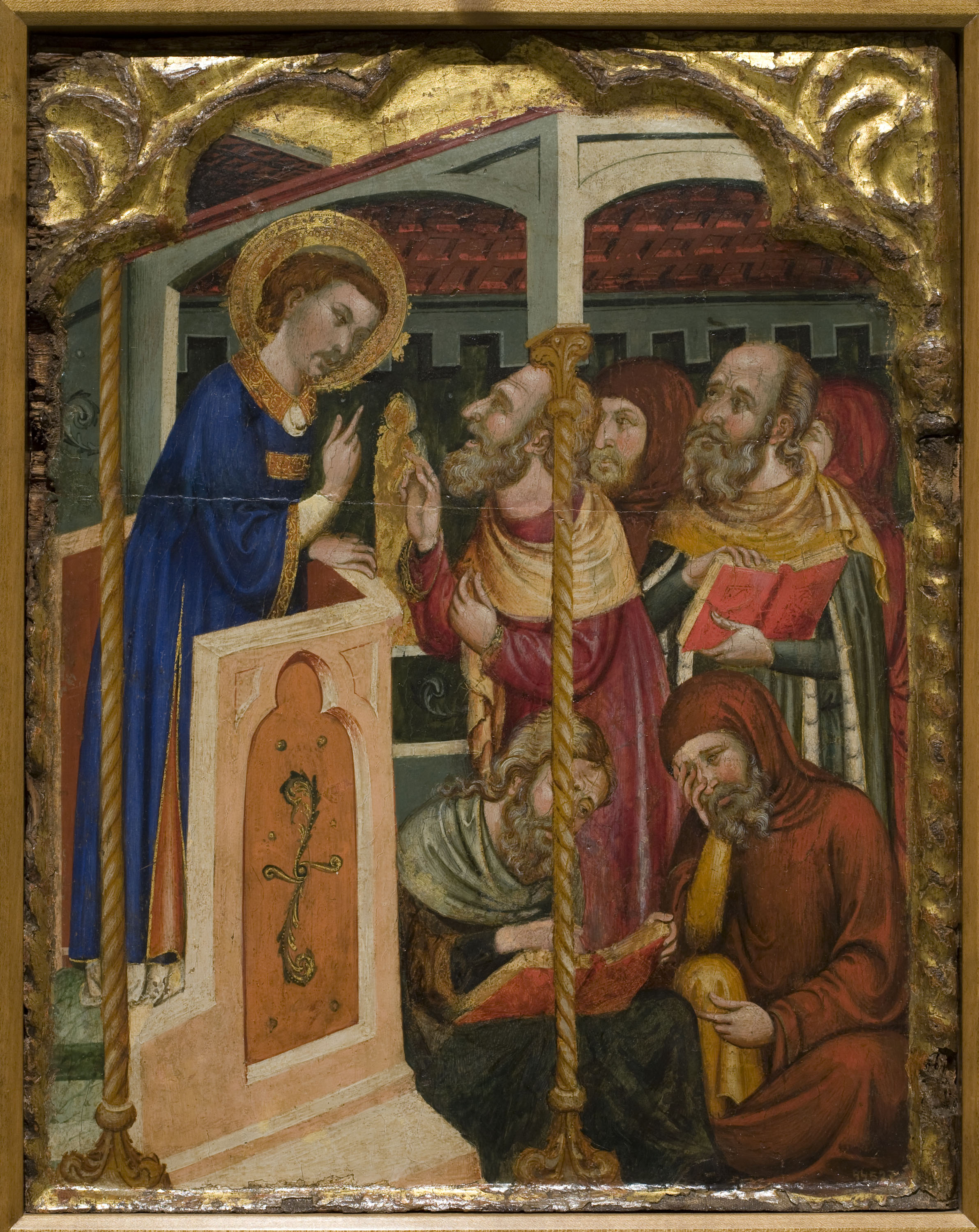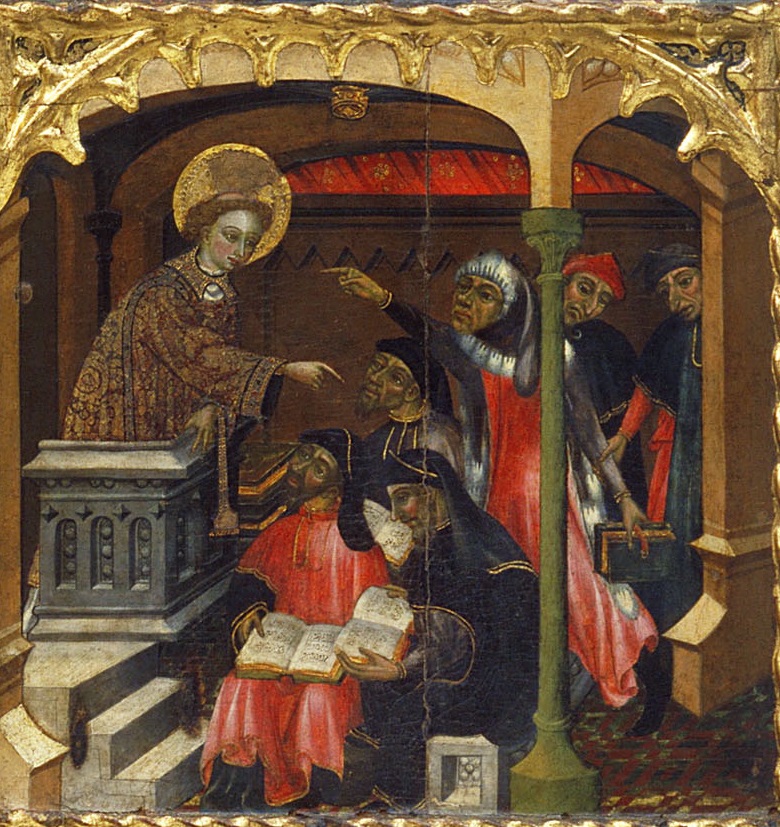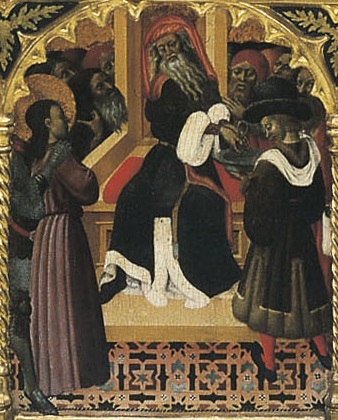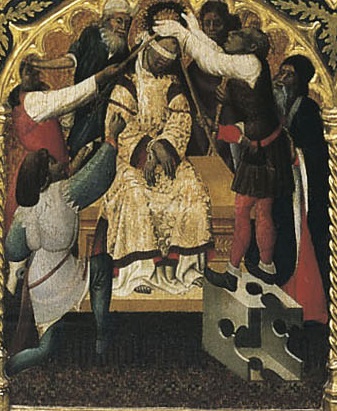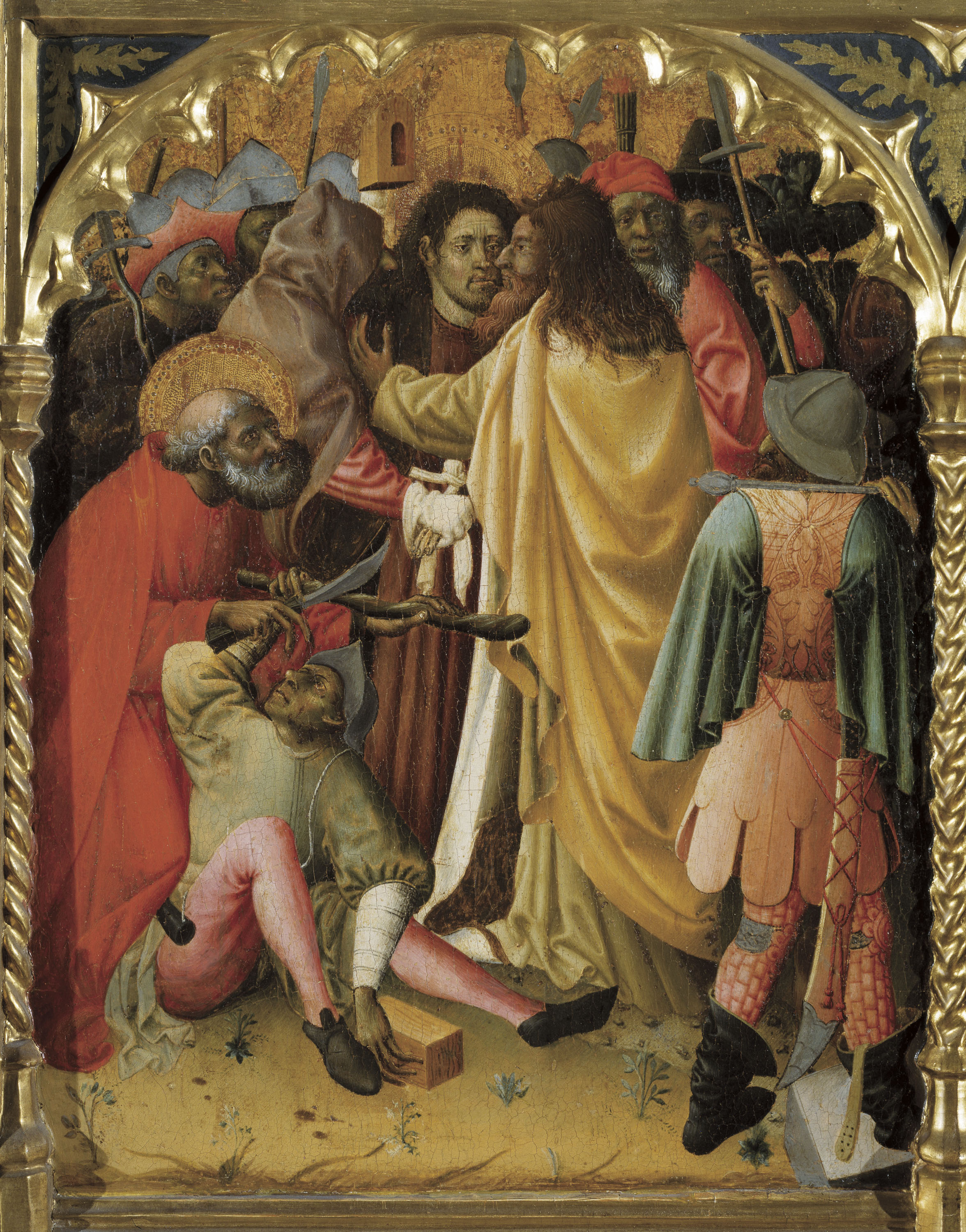Cèsar Favà
The Museu Nacional d’Art de Catalunya’s Gothic Art collection has a varied group of works that enables us to see the different views that Christianity spread of the Jews in the early Middle Ages. Here we shall discuss some images in which the figure of the Jew is portrayed in an openly negative way. This is because art was also a missile used against the Jews (adversus iudaeos).
The Christian image of the Jew
Most medieval images of Jews do not include any distinguishing features. Many of the most important figures of Christianity, constantly depicted in Gothic art, were members of this religion, beginning with Jesus Christ himself, but nothing identifies them as such. However, it is a fact that in the art of the early Middle Ages conspicuous depictions of Jews tend to become widespread, with various mechanisms being used. Among the most common, in Catalonia the way they are portrayed is noticeable for the particular physical appearance and clothing.
Jews are usually recognizable due to their “Semitic profile”, especially a prominent and often aquiline nose, and they are also shown dressed in a long cloak with a hood which, in accordance with the civil legislation in force since the reign of James I, they were forced to wear outside the Jewish quarter. Such laws derived from the ecclesiastic legislation emanating from the 4th Council of the Lateran in 1215, which forced Jews and Muslims to wear conspicuous clothing to prevent them from meeting Christians.
In the museum’s Gothic Art collection, the effects of the measure can be seen in scenes such as the Inscription of the name of John the Baptist, from the Altarpiece of the Saints John from Santa Coloma de Queralt (Conca de Barberà); or the Offering of Saint Joachim and Saint Anne in the Temple, from the inter-beam panel that recently entered the museum thanks to the donation by Antonio Gallardo.

Master of Santa Coloma de Queralt, Naming of Saint John the Baptist Altarpiece of the Saints John, circa 1356
The figurations referred to, it has to be said, do not in themselves exude a negative view of the Jews. What usually connotes them negatively in Christian art is the narrative context into which they are inserted, or their characterization designed to stress their evil nature as the enemies of Christianity. With this objective, the Jewish minority’s anachronistic apparel openly stigmatized them in Catalonia, contributing to worsening relations between both communities. This led to the fateful pogrom of 1391, which destroyed many of the Jewish communities in Catalonia.
The Judeo-Christian controversy
A significant group of images to consider are those that reflect the so-called Judeo-Christian controversy. Their purpose is clearly to show the superiority of Christian doctrine with respect to Jewish and, generically, they evoke the social reality of the time, in which this minority was forced to take part in Christian sermons and in disputes about the faith organized by the hegemonic religion.
In a predella compartment made by a painter from the circle of Ferrer and Arnau Bassa, the dialectic confrontation between Saint Stephen and the Jews clearly shows their role as adversaries of Christianity, as well as the latter denomination’s theological superiority. However, the Jews are not shown in as negative a light as they are in certain works done from the second half of the 14th century onwards, such as the Altarpiece of Saint Stephen from Gualter (La Noguera) and the Altarpiece of Saint John the Baptist and Saint Stephen from Badalona (El Barcelonès). In the first group, some of the Jews in the Dispute, who have long hooked noses and/or special clothes, are seen berating the saint. And not only do they cover their ears and tear up the papers, but in the Stoning of Saint Stephen, also they appear as accomplices to the martyrdom.
This iconographic element is not repeated in the second group mentioned, although the perfidious nature of the rabbis is even more obvious as a result of their depiction, in which some are grim-faced and have sharp exaggerated facial features, like caricatures. The Semitic profile and the long cloak with the hood identify the Jews in the Dispute of the Child Jesus with the Doctors from the Altarpiece of the Virgin and the Eucharist from the monastery of Sixena (Huesca), in which the cliché appears of the heretical books on the ground and a Jew once again tearing up the scriptures.
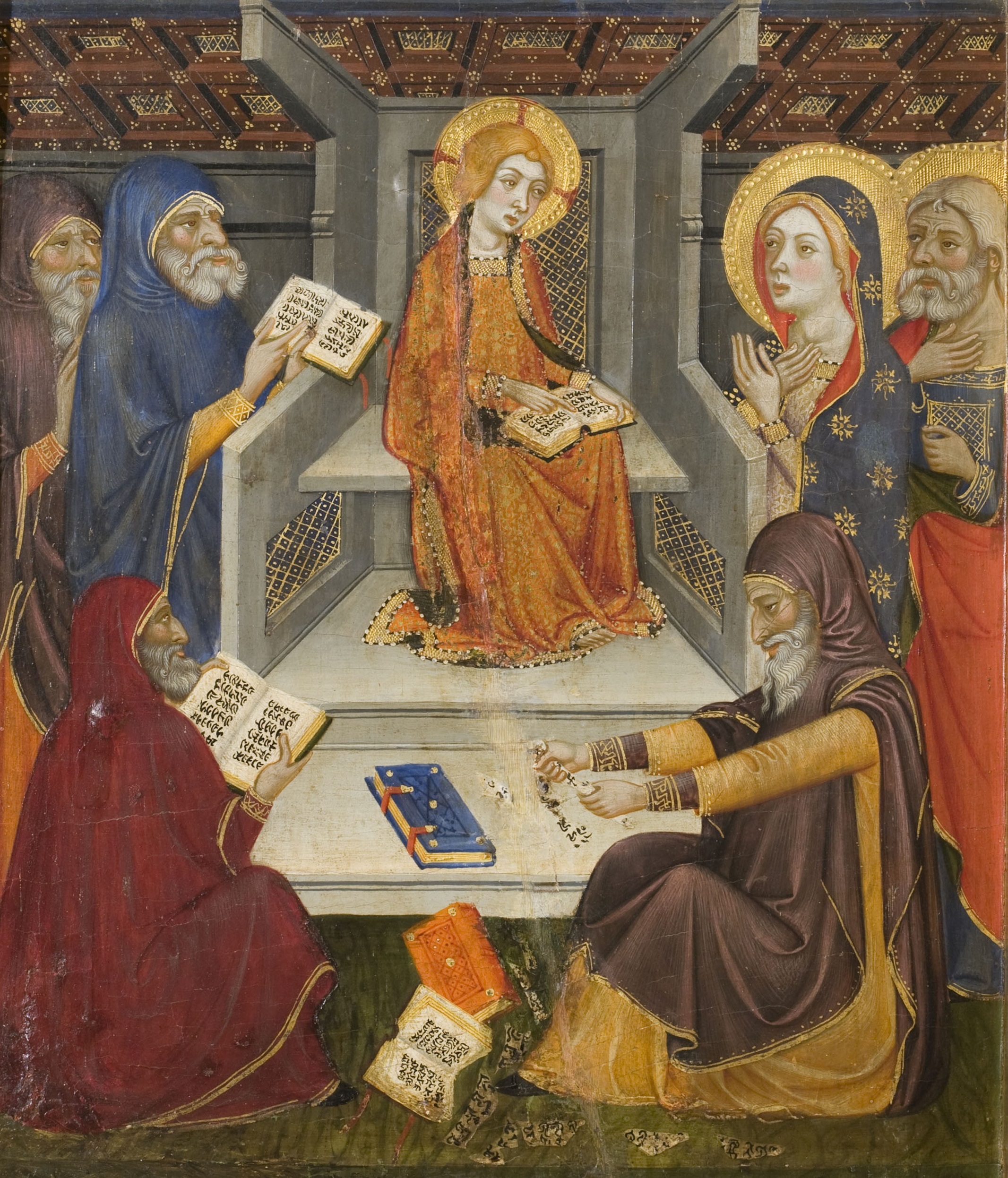
Jaume Serra, Jesus among the doctors from Altarpiece of the Virgin, circa 1367-1381
Jewish deicide
Another group, large and diverse, brings together the images in which the Jews are accused of being responsible for the death of Christ, committing deicide. Blaming them for this follows different strategies, and this is reflected by the works in the collection. Among others, we may refer to the compositions in which the Jew appear explicitly associated with the death of Christ, as is the case in various scenes from the predella of the Altarpiece of Saint Vincent in Menàrguens (Les Garrigues). To be precise, in the depiction of Christ Before Pilate, two hooded Jews flank the governor’s throne and one of them is pointing shamelessly at Jesus; and, in the Crown of thorns, another Jew, dressed the same way, observes the torment from the second row.
Bernat Martorell, compartments of the predella from Altarpiece of Sant Vincent, circa 1438-1440
Another stratagem in the implication of the Jewish people in the death of Christ involves the intentional equation of Judas, the treacherous apostle, with Judaism, habitual in scenes such as the Last Supper or the Arrest of Christ. He often has a Semitic profile, as well as reddish hair and a yellowy tunic, two negative signs given credit in the period. He appears this way, in the representations of Arrest of Christ by the Mestre de Retascón or the aforementioned predella of Menàrguens. And also in the Supper in the middle of the frontal of the above-mentioned altarpiece in Sixena, where, moreover, the figure conceals a black devil visible only to the spectator. Good proof of all these ruses are the scratches that the faithful gave the treacherous apostle.
Finally, in certain cases the implication of the Jews in the death of Christ is subtler, as shown by certain images in which the Romans are transmuted into Jews based on some symbol. In this respect, in the Crucifixion that crowns the Altarpiece of the Virgin of the Milk, Saint Clare and Saint Anthony Abbot, from Xelva, the Roman centurion’s shield features a stylised depiction of the seal of Solomon, also known as the Star of David, which implicates the Jews in the death of Christ.
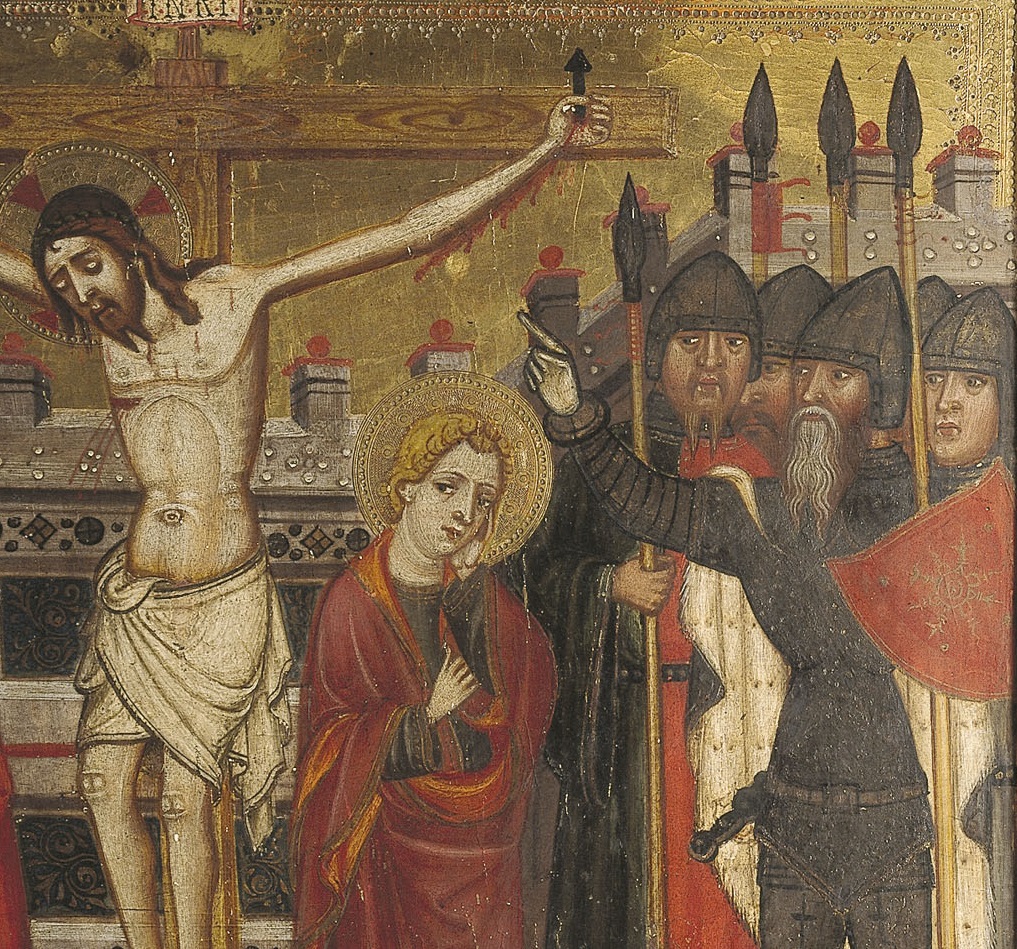
Llorenç Saragossà, Altarpiece of the Virgin Suckling the Child, Saint Clare and Saint Anthony the Abbott, last quarter of 14th century
In other cases, this transformation is provided by a scorpion, commonly interpreted as a symbol of the Jewish people. The image of this arachnid can be seen, for example, on the blade of the axe belonging to one of the Romans who lie dozing around the sepulchre of Christ, in the panel of the Resurrection on the high altarpiece from the monastery of Santes Creus.
Continual deicide
Lastly, a final group of images that I do not wish to overlook are those that show the medieval Jews as sacrilegious beings, prone to continual deicide. In the early middle ages, among other things there is a proliferation of Christian accusations of Jewish blasphemy and insults to Christ and Christianity. In certain places they are incriminated for being involved in evil acts such as the ritual crime of repeatedly performing the Passion and death of Christ on a Christian infant at Easter. Or they are blamed for the profanation of consecrated wafers, in other words, a new murder of Christ, if he is truly present in the bread and the wine of the Eucharist. This last form of insult becomes a habitual theme in altarpieces dedicated to Corpus Christi, as shown in the museum by groups like those from Vallbona de les Monges (L’Urgell), Sigena or Queralbs (El Ripollès).
The torments depicted must be interpreted as a double-edged weapon: on one hand, they advocate the real presence of Christ in the Eucharist, based on the wafers that bleed; and, on the other, they explicitly show the evil nature of the Jews at the time, based on the anachronistic clothes, criminalizing them as enemies of the Messiah that they acknowledge and Christianity.
Àrea d’Art Medieval

